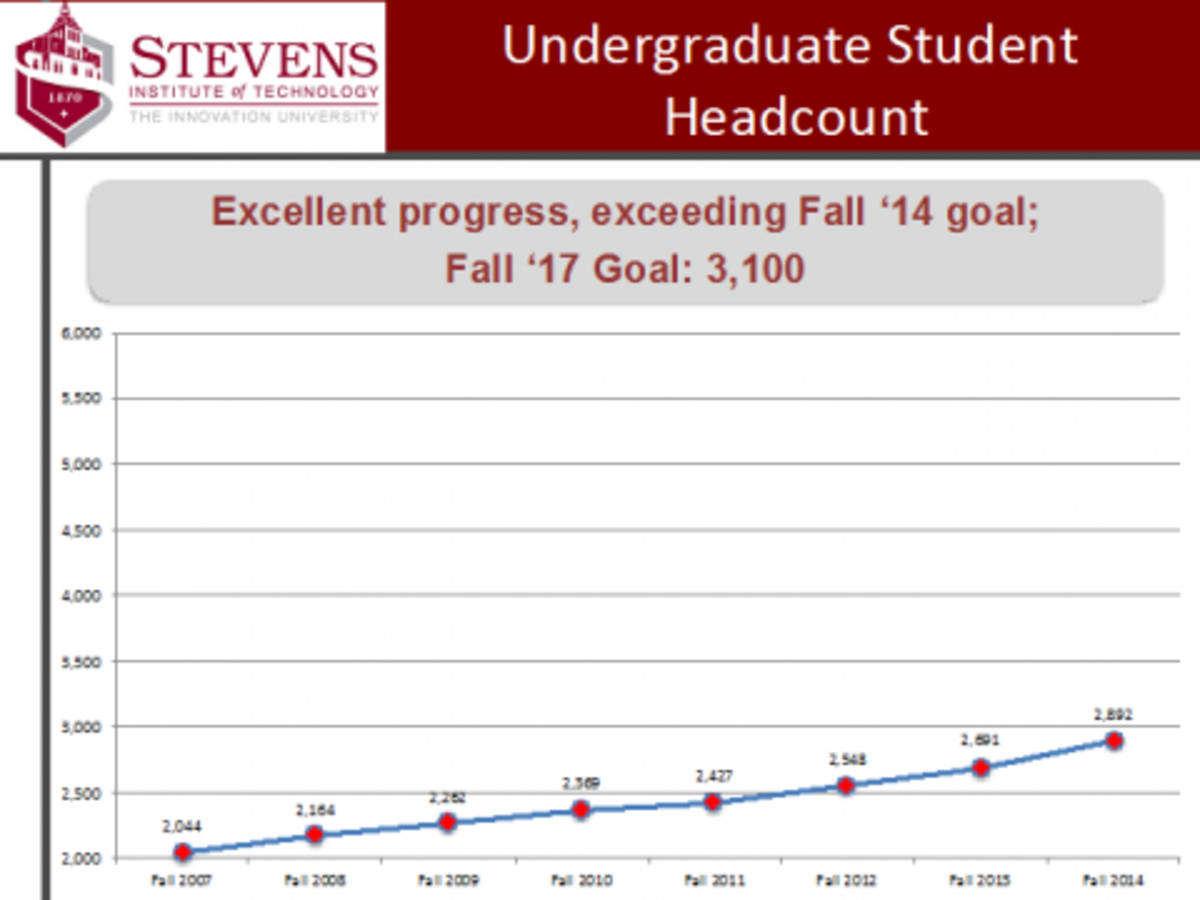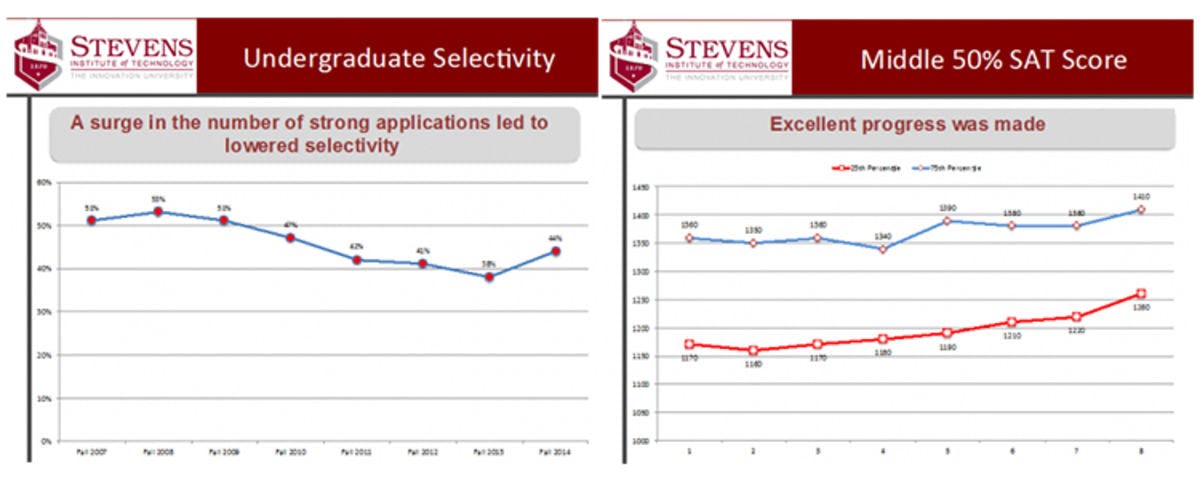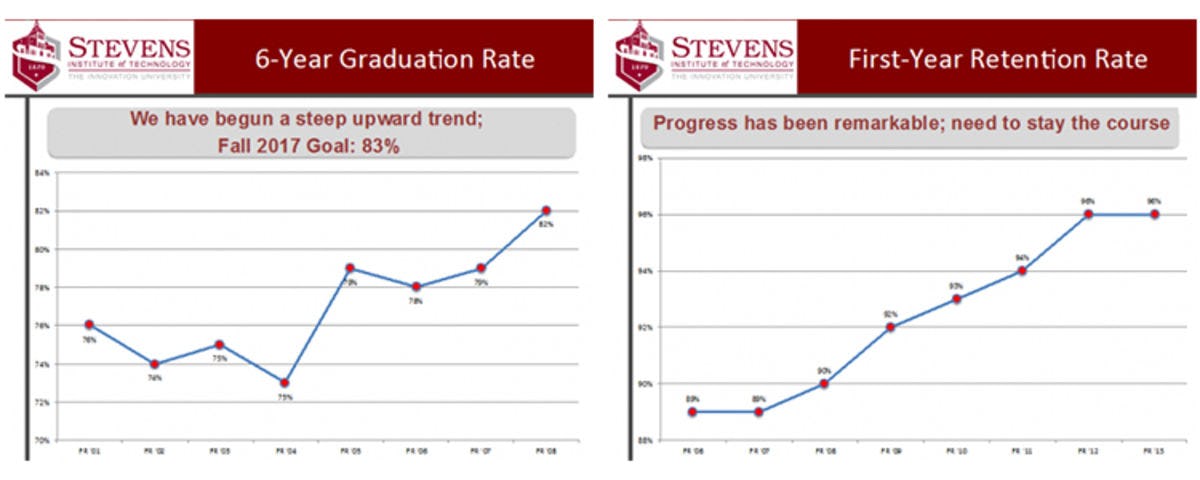Total undergraduate enrollment increased from 2,691 in Fall 2013 to 2,892 in Fall 2014, a seven percent increase. The academic profile and the percentage of out-of-New Jersey students joining Stevens in Fall 2014 also increased. The 96 percent freshman-to-sophomore retention rate was maintained in Fall 2014, and the six-year graduation rate increased from 79 percent in 2013 to 82 percent in 2014. Career placements remained strong, with 95 percent of 2014 graduates in full time employment, graduate school or the military six months after graduation.
Goal U1:
Stevens will have an undergraduate student enrollment of approximately 4,000 from a baseline of 2,427 in Fall 2011. The intermediate goal is to have an undergraduate enrollment of approximately 3,100 by 2017.
OWNER: VICE PRESIDENT MARYBETH MURPHY
Fall 2014 undergraduate enrollment was 2,892, exceeding the Fall 2013 final enrollment figure by 201 students. The Fall 2014 undergraduate cohort (freshman, transfer students and LINK program participants) was 795 new students, exceeding the target of 760. New initiatives were undertaken in the last year to increase the number of applications and to leverage financial aid spending to achieve enrollment and academic profile goals. New outreach and engagement efforts to high school guidance counselors were also initiated in collaboration with the Office of Communications and Marketing.
Year 3: Steady growth targeted toward specific programs; optimize and refine financial aid strategy.
Goal U2:
Continue to improve student selectivity and therefore the academic profile of the incoming class. Specifically, the percentage of first-time, full-time undergraduate applicants who are admitted will be 37 percent by 2017 and 33 percent by 2022, from a baseline of 42 percent in 2011. The middle 50 percent SAT score of new freshmen will improve to 1230-1420 by 2017 and 1280-1450 by 2022, from a baseline of 1190-1390 in Fall 2011.
OWNER: VICE PRESIDENT MARYBETH MURPHY
Due to the exceptional quality of the Fall 2014 applicant pool, Stevens accepted 44 percent of students who applied for admission, with a corresponding increase in the median SAT score. The Fall 2014 middle 50 percent SAT score was 1260-1410, an increase over Fall 2013’s middle 50 percent score of 1220-1380. The middle 50 percent score for ACT test takers also increased to 29-33 from 27-32 in Fall 2013.
Year 3: Continue to improve the academic profile and selectivity of the incoming class.
Goal U3:
The six-year graduation rate will improve significantly with the goal of achieving at least 83 percent in Fall 2017 (for cohort of Fall 2011) and at least 87 percent in Fall 2022 (for cohort of Fall 2016).
OWNER: PROVOST GEORGE KORFIATIS
The Office of the Vice Provost for Academics was established, a Vice Provost for Academics named, and critical functions were staffed during Year 2. In addition, a comprehensive student success framework was developed and executed. Features of this framework that are currently in place include a student tracking process which tracks every undergraduate student’s progress from entry to graduation, an early warning methodology for at-risk students, and a freshman remediation process for students who risk falling behind during their first two semesters. At the completion of the last academic year first-year retention rate remained 96 percent and the six-year graduation rate rose to 82 percent, exceeding a target of 81 percent.
Year 3: Continue to implement control processes and support mechanisms to improve graduation rates.
Goal U4:
Overhaul the academic schedule and implement curriculum changes with the aim of encouraging and facilitating an array of learning opportunities, including interdisciplinary research and development, critical thinking and problem-solving, community service, K-12 STEM mentoring and international experience (Curriculum ++). In May 2018, 100 percent of undergraduate students will graduate having participated in C++.
OWNER: PROVOST GEORGE KORFIATIS + FACULTY SENATE
A number of new out-of-classroom learning experiences were initiated during Year 2.
Year 3: Develop the mechanism to measure the participation of undergraduates in C++ learning experiences and to assess the educational and career preparation outcomes of C++ experiences on students.
Goal U5:
Maintain our stellar placement record for our students and seek to further improve it from our 2011 baseline of 92 percent of students securing post-graduation outcomes as of Nov. 1, 2011.
OWNER: VICE PRESIDENT MARYBETH MURPHY
This is a Year 3 priority. 94 percent of the Class of 2013 secured post-graduation outcomes as of Nov. 1, 2013; 95 percent of the Class of 2014 secured post-graduation outcomes. The full report will be available on Dec. 19, 2014. Efforts of the Office of Career Development have continued to expand the Stevens employer network.
Year 3: Expand support and resources for newer majors and programs and increase services and outreach for graduate students.
Download Class of 2014 Career Outcomes Report >>
Goal U6:
Stevens will have designed, constructed and staffed a Digital Learning Laboratory (DLL), focusing on the research and practice of technology-enhanced learning across all three schools and CAL (by Fall 2017).
OWNER: PROVOST GEORGE KORFIATIS
As Stevens continues to develop its vision for the Digital Learning Laboratory, to be housed in the Academic Gateway building, several initiatives, including institutionally-funded catalyst research projects and the Provost's Digital Learning Initiative to bring interested faculty together to explore common research interests, have been launched.
Year 3: Continue to refine vision of the DLL, recruit and engage faculty in the DLL initiative, and increase research activity.
Goal U7:
A sustained effort consisting of specific initiatives will be undertaken to improve our undergraduate faculty teaching performance and student learning.
OWNER: PROVOST GEORGE KORFIATIS
Preliminary steps, including the establishment of the Center for Faculty Advancement and regular review of teaching evaluations, faculty performance discussions that include analysis of teaching evaluations, and implications for reappointment of non-tenured and adjunct faculty have been initiated during Year 2.
Year 3: Develop a cohesive and integrated plan, including policies, incentives, recognition/rewards, training/support and assessment/feedback for improved teaching and learning.


